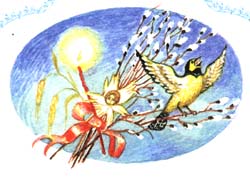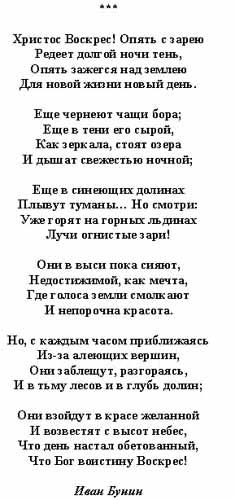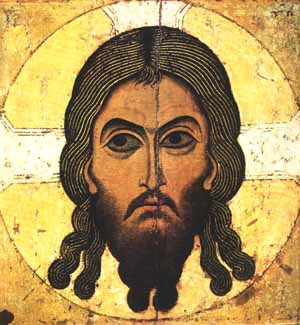
The Holy Face (The Vernical), 1130-1200, Novgorod school.
|
The Holy Face (The Vernical), 1130-1200, Novgorod school. |
Easter is a great celebration of Russian Orthodox Church.
At the Easter night there are a special Easter service in all temples and churches. At the middle of this night all people presented in church come out of the building and make a Cruse Trip around the church. There are priests with the Cross, Gospel, icons and banners in front of this procession. All people have fire candles in their hands and the are singing a special poem:

After that the doors of church become opened and all people enter the church singing a solemn poem:

This poem is the main song for the whole services during the next Holy Week.
|
The Scourging of Christ, end of XV c., Novgorod
|
The Mocking of Christ, end of XV c., Novgorod
|
|
TheProcession to Calvary, end of XVc.,Novgorod
|
Christ ascending the Cross,end of XVc,Novgorod
|
|
The Crucifixion, end of XV c., Novgorod
|
The Deposition, late XV c. Rostov-Suzdal
|
The Deposition: the subject of this icon is taken from the Gospels. The dead body of crucified Christ was taken down by Joseph of Arimathea (at the foot of the Cross, on the ladder), John and Nicodemus (pulling out nails from Jesus Christ's feet). One of the three women is a Virgin pressing Her face to Christ's cheek.
|
The Entombment, late XV c., Rostov-Suzdal school
|
The Holy Women at the Sepulchre, circa 1475, Novgorod
|
The Entombment: according to the Gospels after the Deposition the body of Jesus Christ was wrapped in linen clothes, as the manner of the Jews was to bury, and laid in a sepulcher in the garden.
|
The Anastasis, late XV c., Rostov-Suzdal scool About the Anastasis: according to the legend, Christ, after Resurrection, descended into Hell to lead out Adam and Eve, the Kings David and Solomon, the prophets and forefathers whom he has redeemed from the curse of original sin by His death on the Cross.
|
Christ in Majesty, middle of XVc.,Novgorod Christ in Majesty is a representation of the Divinity, Lord of Heaven and Earth. He is usually depicted within a red rhomboid symbolizing glory. Divine powers are depicted in a green oval with seraphim and cherubim. Than there is a red rectangle. It symbolizing earthly ones sometimes with the symbols of Evangelists in the four corners. |
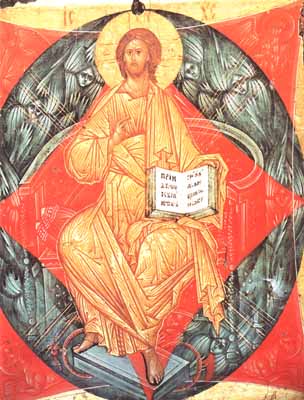
Christ in Majesty, Andrey Rublev, 1410-1415, Moskow School.
Christian iconography has several legends relating to the Vernicle. But in all of them Christ wipes His face with a towel, or napkin, which retains His image.
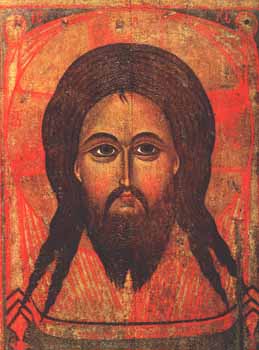
The Vernical, late XIII- early XIV c.,
from the village of Novoe, Yaroslavl
region.
|
The Cross Trip an village Siverskaya, near Saint Petersburg, June, "Tikhvinskaya"Virgin celebration, 9 July, 2003.
|
At the Holy Bowl, Eucharist, city Gatchina, near Saint Petersburg, temple of Peter abd Pavel, 2003.
|
The special Russian meals for Easter is: colored eggs, Easter cake and Passover (curd meal with raises). The legend says that first red egg appeared when Maria Magdalena came to Roman Emperor Tibery. She was a poor woman now as all her property she delivered to poor people. So she brought to Emperor only one white egg. She exclaimed: "Christ has arisen!" "How can it be?" - answered Emperor, "It is as impossible as this white egg become red". And while he was speaking the white egg became red indeed. So Russian people present to each other red eggs during all Holy Week as a symbol of Resurrection. And the answer is: "Truly arisen!"
The Christian romantic of Easter was a subject of creation for famous Russian poets. Here you can see the poems of Alexander Block, Sergey Esenin and Ivan Bunin about Easter. "Verdnoe" (Willow) Sunday is a memory about palm tree branches during the Entrance of Christ to Jerusalem.
|
|
|
